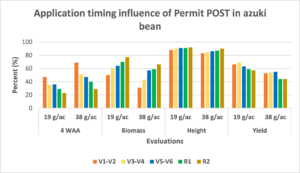Prior to the registration of Permit, post-emergence (POST) annual broadleaf weed control options in dry common beans were limited to Basagran and Reflex. Permit applied POST provides control of some annual broadleaf weeds and yellow nutsedge at use rates between 14 and 28 g/ac. Permit is the only Group 2 herbicide registered for a POST application in dry common beans. POST applications of Permit must include a non-ionic surfactant and can be applied as a directed spray or broadcast. There is a 30 day pre-harvest interval with POST applications of Permit.
Background
Dry common beans (Phasleolus vulgaris) are quite tolerant to POST applications of Permit. Azuki beans (Vigna angularis), on the other hand, are very susceptible to injury from POST applications of Permit. Previous research evaluated dry bean tolerance to Permit applied at the V2 to V3 growth stage (2 to 3 trifoliate). Very little information was available for applications earlier or later than V2 to V3. Weed size, weather conditions and time constraints can often influence application timing. Knowing the response of dry beans to early or delayed POST applications of Permit is important for planning and adjusting to these circumstances.
Evaluations
Six dry bean herbicide tolerance trials were conducted between 2011 and 2013 at the Huron Research Station and Ridgetown Campus to evaluate Permit applied POST on four dry bean market classes (azuki, black, kidney and white) at five application timings. Rates evaluated were 19 g/ac (1X) and 38 g/ac (2X) with a non-ionic surfactant. The 2X rate was applied as two applications at 19 g/ac to simulate a spray overlap. Application timings evaluated were made at V1-V2, V3-V4, V5-V6, R1 (first flower) and R2 (pin bean) plant growth stage. Assessments included visual crop injury 1, 2 and 4 week after application (WAA), plant biomass, bean height and yield. Trials were maintained weed-free.
Results – Azuki bean
Permit applied POST in azuki bean caused significant injury at all five application timings. Injury 4 WAA ranged from 23 to 47% with Permit at 19 g/ac and 29 to 69% at 38 g/ac. Injury was greater with earlier applications of Permit and declined with applications at R1 and R2. Biomass reduction correlated with the injury. There were greater reductions with the V1-V2 application of Permit which reduced biomass by 50% at the 1X rate and 69% at the 2X rate. In comparison, biomass reductions with the R2 application timing were 23% at the 1X rate and 34% at the 2X rate. Interestingly, the impact on yield was the opposite with greater yield reductions at the R1 and R2 application timing. Yield was reduced with the R1 and R2 timing by as much as 43% at the 1X rate and 56% at the 2X rate. In contrast, the V1-V2 timing reduced yield by 34% at the 1X rate and 47% at the 2X rate. The table below shows visual crop injury 4 WAA and biomass, height and yield as a % of the untreated control.

Results – Black, Kidney and White bean
Permit applied POST in black, kidney and white bean market classes evaluated at five application timings did not result in commercially significant injury. Injury 1 WAA ranged from 0 to 5% with Permit at 19 g/ac and 0 to 8% at 38 g/ac. Injury was greater with earlier applications of Permit and declined with applications at R1 and R2. Injury was transient and had diminished to almost zero when evaluated 4 WAA. There was no reduction in plant biomass or plant height. There was no commercially significant reduction in dry common bean yield with yields ranging from 95 to 115% of the untreated control at the 1X rate and 94 to 113% at the 2X rate. Black bean was more susceptible to yield reductions compared to kidney and white bean. Yield was maximized with applications up to first flower. The table below shows biomass, height and yield evaluations of black, kidney and white bean as a % of the untreated control.

Conclusions
Permit can safely be applied POST in dry common bean from the V1 to R1 crop growth stage at rates of 14 to 28 g/ac (the rate range indicated on the label). This wide window of application provides growers with flexibility to target optimum weed staging for greatest levels of control. Applications should be made prior to first flower to maximize crop yield.
Azuki bean is very susceptible to crop injury and yield loss with POST applications of Permit. Permit should not be applied POST in azuki bean. Always check and follow label directions. This research further supports the application of Permit applied POST for volunteer azuki bean control in dry common bean crops.
Permit is another effective post-emergence tool for targeted annual broadleaf weed and yellow nutsedge control in dry common bean. This provides additional options and flexibility for growers to utilize.
For further information please contact Peter Sikkema (psikkema@uoguelph.ca) or Todd Cowan (tcowan@uoguelph.ca)
This article was written by Todd Cowan and Peter Sikkema.